End-of-September Farm Update
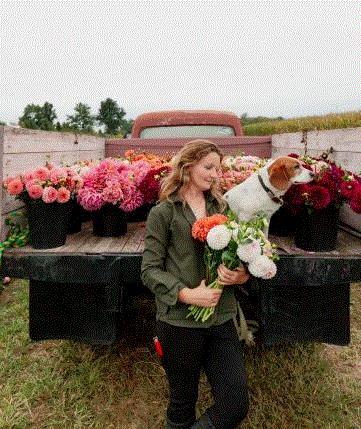
One of the glorious dahlia harvests we had last week, starring our 1955 F350, Cherry Sue.
The dahlias are glorious on the farm right now! The end of peak season is in sight, and I am trying to take a little time each day to walk the fields not for work but for pleasure. It’s easy to take for granted how beautiful the farm is when all I can think about is what needs to be cut for the next day.
The ten-day forecast shows lows in the 40s F for southeast Michigan, meaning the dahlia show will be over before we know it. We’re prepping equipment for field clean up and dahlia digging. It’s crazy to think that in a few weeks it will be time to mow the dahlias back and dig them for winter storage. Last fall we bought a single-row potato digger; this will be the test to see if it works for our farm. If not … Tater and I will be digging more than 20,000 dahlia tubers by hand. Fingers crossed, our best-laid plans will come to fruition and dahlia digging will go without a hitch!
We’re planting stock, snaps, anemone and ranunculus for early winter sales. And we’re eagerly awaiting the heirloom chrysanthemums to start flowering. It’s a juggling act, trying to keep as many balls in the air as we can without dropping any.
I’m also reflecting on the season so far and making mental notes about things we can change and improve on. To be honest, the flowers are the easy part. The people are the challenge, whether it be employees, customers, or me. There have been countless humbling experiences this season. We’re not just growing flowers, I’m trying to grow myself and the farm, too. Eating crow and embracing growing pains isn’t something I enjoy. However, for the farm to turn into the flourishing business I want it to, I need to work on myself so that Forget Me Not can grow.
Excellence starts at the top, and I’ve been looking in the mirror a lot lately and seeing what needs to be worked on. Entrepreneurship is quite the journey and it’s anything but linear. But at least flower farming is breathtakingly beautiful … so the occasional unexpected turn is welcome. This season has been a humble reminder that I have a lot more work to do.
In this edition of Bloom Beat, we’re talking about the Michigan Field to Vase Dinner, the infamous daffodahlia and more. With all that being said, let’s talk shop!

Field to Vase Dinner Recap
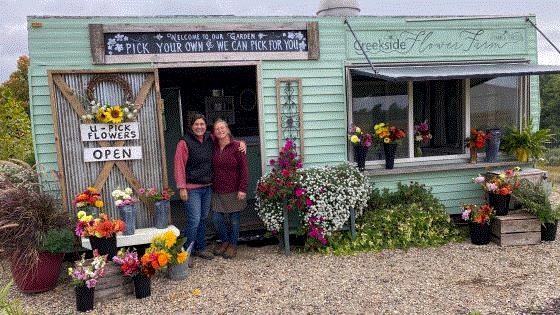
Sue Dykstra, owner of Creekside Growers at her cute flower stand on her farm.
Earlier this month, I had the pleasure of attending a Certified American Grown Field to Vase dinner at Creekside Growers in Douglas, Michigan. Sue Dykstra, owner of Creekside, started growing perennials and annual bedding plants in 2000 and opened her retail garden center in the early 2000s. In 2016, she planted a half-acre cutting garden. Sue’s cut flower operation continued to grow, and even started to outshine the garden center.
She then made the switch to establish Creekside Growers as the local flower hub for Western Michigan and the home of the West Michigan Flower Market. The West Michigan Flower Market is a consortium of thirteen flower farms in Michigan who pool their flowers together to sell to florists in Western Michigan, Indiana and beyond.
Sue’s farm was a perfect place for a Field to Vase Dinner It was one of the most magical nights of my life. Surrounded by local flower fanatics, breathtaking floristry and divine food, I couldn’t ask for much more. Every bite of food and every sip of wine was from West Michigan’s best makers and culinary experts. I quickly became friends with the strangers at the dinner table. The love for local flowers and food is a powerful common thread that makes strangers into fast friends.
Certified American Grown (CAG) is a tremendous industry organization that more flower farmers need to be aware of. The Certified American Grown label helps consumers differentiate American-grown flowers from their imported counterparts. As many of you know, the public does not know where most of their flowers come from. But when given a choice, or an American-grown label, 65% of purchasers will choose American-grown flowers. CAG also lobbies Congress for industry friendly legislations to ensure domestic flower farms can stay competitive in the marketplace.
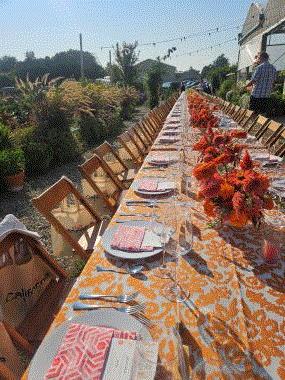 |
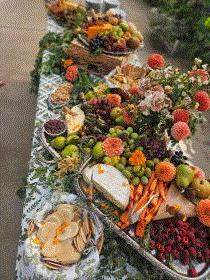 |
Every year CAG organizes Field to Vase dinners at flower farms across the country. Attendees enjoy a farm to table dinner, immersed in fields and greenhouses full of flowers, and the night is filled with networking, floral demos, and education. People from all walks of life attend these dinners; it’s a creative way to bring industry, flower farmers and flower consumers together in a beautiful way. The proceeds of these dinners help raise funds to lobby Congress, and to create marketing and promotional materials to educate the general public on the importance of American-grown flowers. The Creekside Growers dinner in Douglas was the last for this year. But I encourage you to consider attending a dinner next season. It’s one of my favorite industry memories to date!

Meet the Daffodahlia!
It's a fun time in the dahlia world right now. Flower farmers and backyard gardeners alike are trying their hand at dahlia breeding and starting dahlia seed mixes in hopes to find the next best dahlia.
Kelsey Hall, owner of Cattle and Cut Flowers in Enumclaw, Washington did just that. Everyone, meet the daffodahlia!
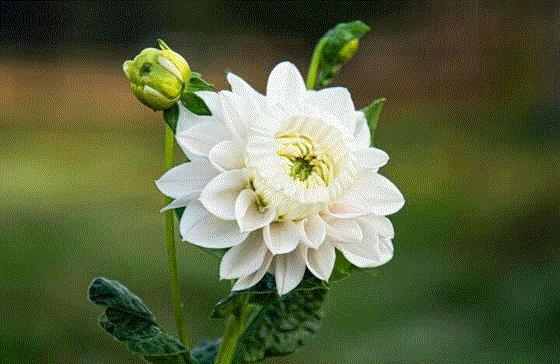 Meet the daffodahlia, a dahlia that resembles a daffodil. Photo by Kelsey Hall
Meet the daffodahlia, a dahlia that resembles a daffodil. Photo by Kelsey Hall
The daffodahlia is a beautiful soft blush cream color with a darling fluted corona in the center, similar to daffodils. Kelsey found this treasured flower on six plants in her high tunnel. Even Martha Stewart highlighted the daffodahlia on her Instagram! This new dahlia form is an exciting innovation … that is, if the genetics are stable. It’s going to take a few years to determine this.
Kelsey posted on Instagram that they are taking cutting and will light them throughout the winter to multiply stock, and they are taking every precaution to get the plants tested for viruses. Folks may have to wait until 2028 or longer to get their hands on a prized tuber. But in the meantime, Kelsey states that they will have their “bridal tunnel dahlia seed mix” available the week of October 11. The bridal tunnel seed mix is an open=pollinated mix of seeds with the daffodahlias and other pastel, white and blush mix dahlias in her high tunnel. Feeling lucky? You can try your luck and see if you can get a daffodahlia of your own in the mix.
Innovations like this are fun to watch. It would be thrilling to have a new dahlia form on the market. Are you growing dahlias from seed this season? What are your favorite seedlings on your farm this year? Tater and I would love to know. Email us!

More on Boron
In our last edition of Bloom Beat, Tater and I talked about correcting boron deficiencies in our chrysanthemum crop. In case you need a refresher on the importance of boron, here is a great article from GrowerTalks. Below is an additional note from our friend Dr. Will Healy, retired senior technical and research manager at Ball Horticulture, regarding boron. As always, thank you, Dr. Will, for the input!
It is important to note that boron is not very soluble in water. Seasoned growers with perennial boron issues in their crop will mix boron in a small glass container before adding it to their fertilizer tank mix. This ensures that the boron will be present throughout the tank mix. If you use Borax for correcting your boron deficiency, always be sure to “boil boron” into the solution which will allow it to dissolve. Solubor, a commercial grade concoction to fix Boron deficiency, is more soluble in water and will mix into tank solutions with just warm water. According to Dr. Will, when you see that you have boron deficiency, you can add up to 0.5 ppm total boron (water + fertilizer) with every irrigation. But greater than 1.0 ppm can be a problem! Pansies and petunias are particularly sensitive to low boron. That is why the “Peter’s Pansy Special” has a higher boron content at 200 ppm. Peters only provides .4 ppm boron since they assume the local water supply also has some boron in it.

Ohio Floriculture and Nursery Conference
Mark your calendar for the first Ohio Floriculture and Nursery Conference. This one-day conference is being organized by Dr. Garrett Owen, the Sustainable Greenhouse and Nursery Production System Specialist from Ohio State University. I know Dr. Owen personally, and everything he does is top-notch!
Topics are geared towards potted ornamentals and nursery production. But don’t be fooled—here is tremendous overlap between annual basket production and cut flower farming. Tater and I have learned a lot about by attending conferences like this and applying the concepts to our little farm. We are particularly excited about the daily light integral talk by Dr. Owen, and Dr. Chris Currey’s keynote talk about finishing annuals efficiency. (Flower farmers, see the overlap yet?)
The best part is, you can attend this event in person or virtually. The conference is on Thursday October 17, at OSU’s Controlled Environment Agriculture Research Complex in Columbus.
Check out the full program schedule HERE.

Enthusiastically!
Lindsay Daschner (and Tater)
Editor-at-Large—Bloom Beat
Owner—Forget-Me-Not Farms
This email was received by 6,313 of your fellow fresh-cut flower growers!
If you're interested in advertising in Bloom Beat, contact Kim Brown and she will hook you up!